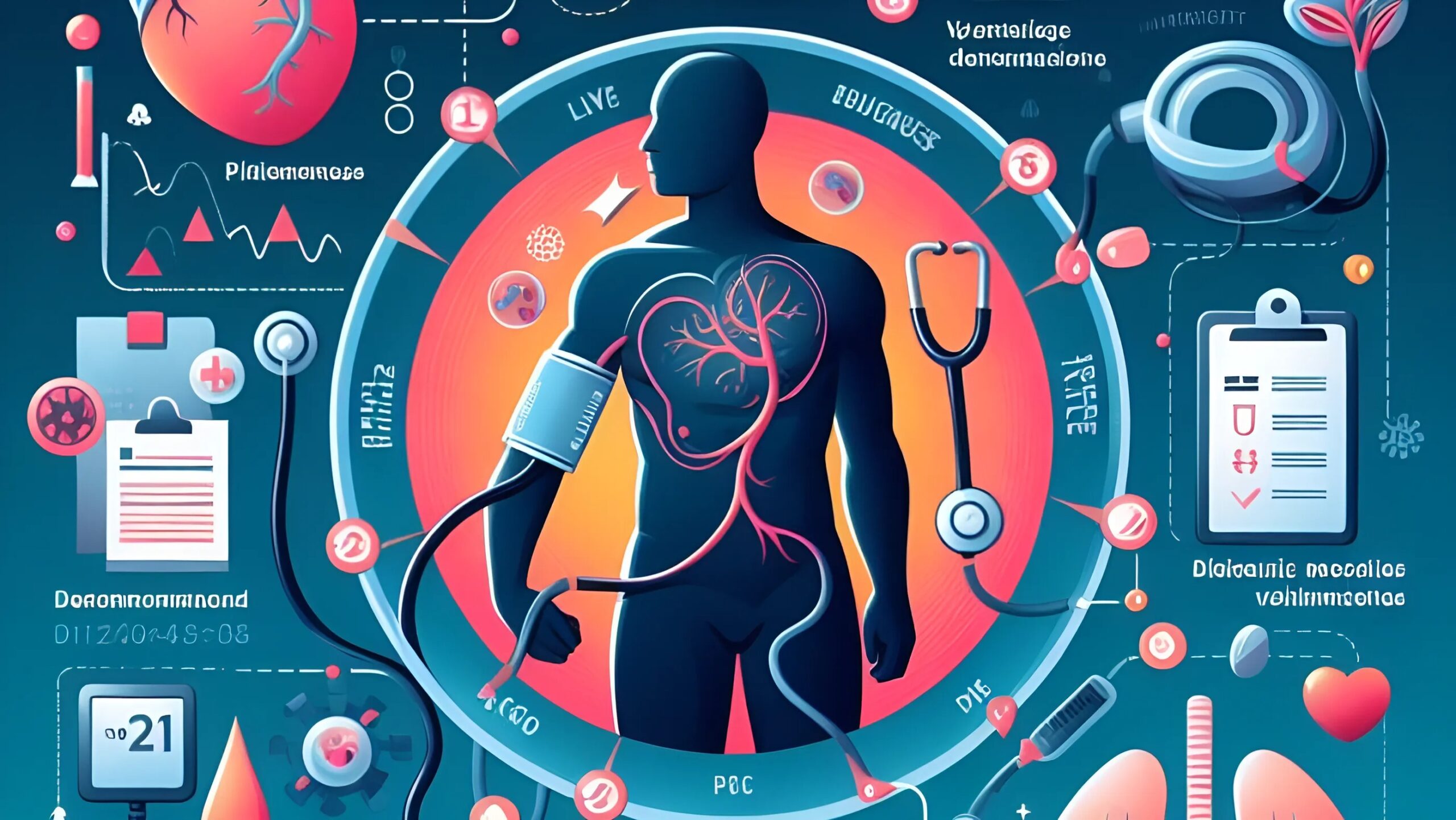
Introduction
Blood pressure is a critical indicator of our overall health, acting as the silent, pulsing metric that dictates the rhythm of our daily lives. Understanding blood pressure and recognizing the importance of maintaining healthy levels is paramount for a vibrant, energetic life. It’s the force that propels life-giving blood through the highways of our circulatory system, but when this force exceeds healthy boundaries, it becomes a stealthy adversary.
The question of how to lower blood pressure naturally is a quest for many. With healthy blood pressure ranges typically falling between 120/80 mmHg and 130/85 mmHg, it’s essential to stay informed about what causes high blood pressure. Factors range from dietary choices to stress levels, and recognizing them is the first step in prevention and management.
Incorporating natural ways to lower blood pressure into one’s lifestyle can be transformative. Whether it’s through mindful dietary adjustments, regular physical activity, or stress-reducing practices, the path to optimal cardiovascular health is within reach. This blog post aims to enlighten you on these key aspects, guiding you towards a heart-healthy future. Let’s embark on this journey together, understanding the beats of our hearts and the power we have to control them.
Healthy Blood Pressure Ranges
Navigating through the landscape of healthy blood pressure ranges is akin to finding a balance in the ebb and flow of life. Normal blood pressure hovers around the serene shores of 120/80 mmHg, a number that signifies a harmonious relationship between the heart and the arteries. However, when the scales tip towards hypertension—a reading above 130/90 mmHg—it’s a sign that the heart is facing a stormy sea, working overtime to pump blood. Conversely, hypotension—below 90/60 mmHg—suggests a tranquil but perhaps too lethargic flow. Understanding what causes high blood pressure and embracing natural ways to lower blood pressure can steer us back to calm waters.
What Causes High Blood Pressure
High blood pressure, often termed the ‘silent killer’, can sneak up without warning, and its roots can be as complex as the intricate web of arteries in our bodies. Genetic factors play a pivotal role; if your family tree is entwined with hypertension, you may be more susceptible to this condition. Yet, it’s not just about the cards you’re dealt; it’s also how you play them. Lifestyle choices—the foods we savor, the stress we shoulder, and the movement we muster—can all contribute to elevated blood pressure levels.
Here’s a snapshot of how lifestyle intertwines with hypertension:
- Dietary Decisions: High sodium intake, excessive alcohol, and a diet low in potassium can raise blood pressure.
- Physical Inactivity: A sedentary lifestyle can weaken the heart, requiring more effort to pump blood.
- Stress: Chronic stress can cause temporary spikes in blood pressure and long-term damage.
- Sleep Habits: Poor sleep can harm the body’s ability to regulate stress hormones, impacting blood pressure.
Understanding these factors is crucial in navigating toward healthy blood pressure ranges. Embracing natural ways to lower blood pressure, such as dietary changes, exercise, and stress management, can mitigate these risks and lead to a healthier heart rhythm.

Risk Factors for High Blood Pressure
The tapestry of risk factors for high blood pressure is woven with various threads, each representing a different aspect of our lives and backgrounds. Age and gender are significant strands; as we age, the risk of hypertension increases, and men and women may experience different patterns of blood pressure changes over their lifetimes. The hues of our ethnicity and race also color our risk profile, with some groups having a higher predisposition to hypertension than others.
Interlaced with these are other health conditions that can elevate the risk, such as diabetes, obesity, and kidney disease. These conditions can create a cascade effect, amplifying the likelihood of developing high blood pressure.
Understanding these risk factors is crucial, not just for awareness, but for action. By knowing how to lower blood pressure through lifestyle changes and natural ways to lower blood pressure, we can aim for healthy blood pressure ranges and reduce the risk of hypertension. It’s about taking control of the weave of our health, ensuring that each thread strengthens rather than weakens the fabric of our well-being.
The Dangers of Untreated High Blood Pressure
Untreated high blood pressure, or hypertension, poses significant risks to cardiovascular health and can adversely affect one’s overall well-being. It is often dubbed the “silent killer” because it can cause damage without manifesting any obvious symptoms. High blood pressure can lead to severe conditions such as heart attacks, strokes, and other life-threatening complications. Understanding what causes high blood pressure is crucial; it can stem from a variety of factors, including genetics, poor diet, lack of exercise, and stress.
Maintaining healthy blood pressure ranges is essential for preventing these risks. Typically, a blood pressure reading below 120/80 mmHg is considered optimal. To achieve this, one might explore natural ways to lower blood pressure, such as regular physical activity, a balanced diet rich in fruits and vegetables, and reducing sodium intake. Additionally, managing stress through relaxation techniques and getting adequate sleep can also contribute to healthier blood pressure levels.
For those wondering how to lower blood pressure, it’s important to consult with healthcare professionals who can provide personalized advice and, if necessary, prescribe medication to help manage hypertension. Remember, taking proactive steps towards controlling blood pressure not only protects your heart but also enhances your quality of life.

Natural Ways How to Lower Blood Pressure
Exploring natural ways to lower blood pressure is a holistic approach that can significantly improve your cardiovascular health and contribute to maintaining healthy blood pressure ranges. Here’s how you can manage your blood pressure through lifestyle and dietary changes:
Dietary Changes for Blood Pressure Management:
- Incorporating More Fruits and Vegetables: Fresh produce is rich in essential vitamins and minerals that support heart health. Aim for a colorful variety on your plate.
- Reducing Sodium Intake: Cut back on salt, and be mindful of hidden sodium in processed foods to help reduce blood pressure levels.
- Importance of Potassium-Rich Foods: Foods like bananas, spinach, and sweet potatoes are high in potassium, which can help counteract the effects of sodium and lower blood pressure.
The Role of Exercise in Blood Pressure Regulation:
- Aerobic Activities: Regular activities such as walking, jogging, cycling, or swimming can improve heart health and lower blood pressure.
- Strength Training: Incorporating moderate resistance training can also aid in managing hypertension.
Stress Management Techniques:
- Meditation and Mindfulness: These practices can reduce stress, which is a common factor that causes high blood pressure.
- Yoga and Tai Chi: Gentle exercises that combine physical movement with breath control and meditation can be beneficial.
Herbal Remedies and Supplements for Blood Pressure Control: While some herbal remedies and supplements may contribute to blood pressure management, it’s important to consult with a healthcare provider before starting any new regimen, especially if you’re already on medication.
Remember, understanding how to lower blood pressure involves a commitment to a healthier lifestyle. By making these changes, you can take control of your blood pressure and enhance your overall well-being.
Lifestyle Adjustments for Blood Pressure Reduction
Lifestyle adjustments are a cornerstone in the quest to lower blood pressure and maintain healthy blood pressure ranges. Here’s a focused look at how certain changes can make a significant impact:
Quitting Smoking and Limiting Alcohol Consumption: Smoking cessation is one of the most effective changes you can make. Not only does it reduce blood pressure, but it also decreases your risk of heart disease. Similarly, moderating alcohol intake can prevent spikes in blood pressure and contribute to overall cardiovascular health.
Achieving and Maintaining a Healthy Weight: Excess weight can cause high blood pressure by increasing the workload on your heart and blood vessels. Shedding extra pounds is often followed by a reduction in blood pressure readings, moving you closer to a healthier range.
Establishing Healthy Sleep Patterns: Quality sleep is vital for heart health. Establishing a regular sleep schedule and ensuring you get 7-9 hours of uninterrupted sleep can help regulate blood pressure and improve your body’s ability to manage stress.
By embracing these lifestyle adjustments, you address what causes high blood pressure and employ natural ways to lower blood pressure. It’s a holistic approach that not only enhances your health but also enriches your quality of life.

Implementing Mindful Eating Habits
Implementing mindful eating habits is a transformative step towards achieving healthy blood pressure ranges and understanding how to lower blood pressure. Here’s how you can integrate mindfulness into your eating practices:
Portion Control: Being aware of the amount of food you consume is key. Use smaller plates, and before going for seconds, take a moment to assess whether you’re still hungry.
Reading Food Labels: This habit can help you make informed choices about the foods you eat. Pay attention to serving sizes, the amount of sodium, and the presence of added sugars.
Mindful Eating Practices: Mindful eating involves being fully present during meals, savoring each bite, and listening to your body’s hunger and fullness cues. It’s not just about what you eat, but also how you eat.
By focusing on these aspects, you’re not only addressing what causes high blood pressure but also adopting natural ways to lower blood pressure. Mindful eating can lead to better food choices, improved portion control, and a more harmonious relationship with food and health.

The Importance of Regular Monitoring
The journey to maintaining a healthy blood pressure range is a vigilant one, and regular monitoring is a cornerstone of this process. Utilizing home blood pressure monitors not only serves as a convenient tool for keeping an eye on your numbers but also acts as a first line of defense in identifying what causes high blood pressure in your personal health landscape.
By tracking your progress, you can discern patterns and triggers, allowing for timely adjustments in lifestyle or medication. This proactive approach is instrumental in discovering natural ways to lower blood pressure, such as dietary changes, exercise, and stress management. Moreover, understanding how to lower blood pressure through these monitors can lead to informed discussions with your healthcare provider, ensuring a tailored approach to your health.
Remember, the power to control and improve your health lies in the palm of your hand, quite literally, with each press of the monitor’s button. Stay informed, stay proactive, and let the silent whispers of your heart guide you to a healthier tomorrow.
FAQs on Blood Pressure Management
Q: How do I lower blood pressure quickly?
A: To lower blood pressure quickly, you can try deep breathing exercises, mild physical activity, or drinking water. In some cases, medications may be necessary.
Q: How to decrease BP naturally?
A: Natural ways to decrease blood pressure include regular physical activity, reducing sodium intake, managing stress, and maintaining a healthy weight.
Q: What food lowers blood pressure?
A: Foods known to help lower blood pressure include leafy greens, berries, oats, bananas, and garlic. Incorporating these into your diet can contribute to healthier blood pressure ranges.
Q: Can garlic lower blood pressure?
Q: Does lemon water lower blood pressure?
A: Lemon water contains compounds that may help relax and dilate blood vessels, which could result in lowered blood pressure.
Q: What is good blood pressure by age? A: A healthy blood pressure range is generally considered to be below 120/80 mm Hg for adults, regardless of age.
Q: Is BP 140/90 normal range?
A: No, a blood pressure reading of 140/90 mm Hg or higher is considered Stage 2 hypertension. It’s recommended to aim for lower blood pressure.
Q: What are the main causes of high blood pressure?
A: The main causes of high blood pressure include genetics, lack of physical activity, poor diet, obesity, and certain health conditions like diabetes and kidney disease.
Remember, managing blood pressure is a long-term commitment. Regular check-ups and lifestyle adjustments are key to maintaining healthy blood pressure ranges. Consult with a healthcare provider for personalized advice.
Conclusion
In conclusion, understanding what causes high blood pressure and how to navigate healthy blood pressure ranges is a crucial aspect of maintaining our overall health. The journey of how to lower blood pressure naturally is not a sprint but a marathon, requiring consistent efforts and lifestyle modifications. By incorporating natural ways to lower blood pressure into our daily routines, we can effectively manage our cardiovascular health. This includes mindful dietary choices, regular physical activity, stress management, and regular monitoring of our blood pressure. Remember, the power to control and improve our health lies within us. Let’s embrace these strategies and steer towards a heart-healthy future.
